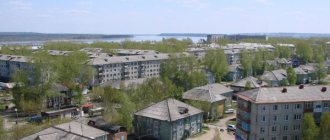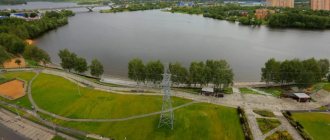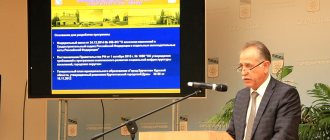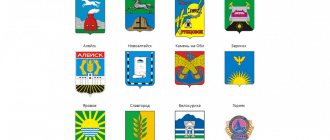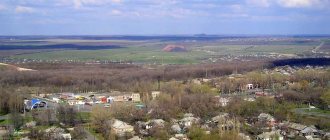One of the most famous early mentions of these places (1903) is a note in the travel diary of the famous polar explorer V. A. Rusanov. He admired the magnificence of the steep banks and the Pechora River and expressed hope that Pechora will soon take its rightful place on the map of Russia and a modern city will be built here, whose residents will be able to endlessly enjoy the wonderful landscapes.
But, unfortunately, since the 30s of the last century, the history of these uniquely beautiful places has been associated with camps and exile. Dispossessed peasants, former Vlasovites and “politicals” were sent here. In 1937, GULAG prisoners began building a railway line here, and in 1942 the Kanin Nos pier appeared. The year of foundation of the city is considered to be 1949, when the villages that grew up next to the pier and railway station were united into one municipality. At the same time, the city of Pechora became the administrative center of the Kozhvinsky district.
Characteristics of the city of Pechora
The area of the modern city is just under 30 square meters. km, more than 40 thousand people live in it. The satellite map of Pechora clearly shows that the city, based on two separate settlements, is still characterized by uneven urban development (no more than 31% of the land is built up). The reason is a large swampy lowland located within the city limits - a place of annual flooding.
Until the 70s. last century, Pechora was built up with small one- and two-story buildings, which were then replaced by five- and nine-story buildings.
Pechora has its own ice palace, sports school and art school, several cultural centers, as well as 25 clubs and more than 20 libraries throughout the area, its own industrial and economic college, and a branch of the State St. Petersburg University of Water Communications has been opened.
What to see from museums in Pechory
There are several interesting museums in the city. Each of them demonstrates the history of the region and town in its own way. Here you can spend time on your own or with a guide with benefit and pleasure - both adults and children, especially schoolchildren.
City History Museum
- Address – International, 6.
It opened back in 1920. However, most of the exhibits were lost in the fire of war. In the middle of the last century, the collection began to take shape anew. The museum currently hosts several exhibitions. Some of them are aimed at demonstrating archaeological and ethnographic finds. Part is devoted to the study of the history of the USSR. There is an exhibition where ceramic and porcelain products are shown. Special attention is paid to fine arts.
Museum-Estate of the Seto People
- Address: Sigovo village.
Seto are a people who live on the border between Russia and Estonia. It has preserved its culture, traditions and mentality. The museum exposition is dedicated to this glorious ethnic group. The establishment is located on the territory of an old estate.
The complex includes a manor house, a barn, a barn and a bathhouse. Visitors can get acquainted with household items, costumes, furniture, and household utensils characteristic of Seto. The museum staff takes its guests into the fabulous world of legends, traditions and tales.
Flax Museum "Linen Province"
- Address - Rizhskaya st., 75B.
Created within the framework of the cultural and educational project “Linen Province”. This is a tribute to the past of the Pechora region, which once produced huge quantities of flax. The museum presents historical information about flax production in the Pskov region and stories about people who were involved in flax at one time or another.
Fascinating excursions are held here in the form of lively conversations. There are elements of theatrical performance. Those interested can familiarize themselves with the line of men's and women's linen clothing.
Pechora on the map of Russia: geography, nature and climate
The city is located on the Pechora Lowland (with a characteristic slightly hilly topography), along the right bank of the river of the same name. It is considered one of the greenest cities in the North - the area occupied by vegetation within the city is 28 hectares.
The climate is temperate continental with cold winters (average air temperature from -15°C to -18°C) and short, not very hot summers (+12°C – +16°C). From mid-May to the end of July is the time of white nights.
Due to the difficult climate, living conditions in the territories of the city and surrounding areas are equal to the conditions of the Far North.
Architectural monuments
| Photo | Description |
| The Pechora Palace of Culture was built in 1949 as a theater building for the cultural and educational department of the Pechorzheldorstroy of the USSR Ministry of Internal Affairs. The theater troupe consisted of about 140 actors, singers, and musicians. Since 1954 - Palace of Culture for railway workers of the Vorkuta branch of the Northern Railway. Located on the street. Soviet. Included in the state list of historical and cultural monuments. |
Routes on the map of Pechora. Transport infrastructure
The city of Pechora has its own railway station (Komi Republic, Pechora, Privokzalnaya St., 3a), and the local “ Pechora River Shipping Company ” (Nikolai Ostrovsky St., 63B, Pechora) remains to this day one of the largest transport enterprises of the republic.
It has its own airport (42 Svobody St., Pechora), providing air communication with Syktyvkar.
Road transport communication is difficult, but construction is already underway on a large Ukhta-Naryan-Mar highway, which will pass through the territories of Pechora and Usinsk. In the meantime, car owners have to use the ferry services connecting Pechora and Vuktyl.
There are 6 municipal bus routes in the city itself. They can be found on the map of Pechora with streets (along the City Ring, from the railway station to: city hospital, airport, Vostochny village; from city hospital to: State District Power Plant, Gorky Square). Travel from Pechora, including to the villages of Naberezhny, Kozhva, Izyaya, Ozerny, Bely Yu, and the villages of Byzovaya, Ust-Kozhva, Medvezhskaya, Konetsbor, is provided by minibuses.
Unusual sights of Pechory
Yes, these are not the most prominent objects in the city. You can easily walk past the Archer's House and simply not notice the Lantern Monument. But you shouldn't do this. On the contrary, pay attention to the sights that have survived to this day thanks to active citizens.
Sagittarius house
- Address - st. Verkhovicha, 4.
This is a real monument of wooden architecture. It was built at the beginning of the 18th century. It is a two-tier log house on a low stone foundation.
The unique building has survived to this day. At one time, archers lived in it, who, on the orders of Ivan the Terrible, protected the monastery from foreigners. Then a whole Streletskaya settlement formed around the holy place. But only one house survived to us.
Now it is in disrepair. A group of concerned people is fighting for recognition of this object as an architectural monument.
Monument to the street lamp
- Coordinates on the map are 57.813082, 27.612690.
This is a relatively young monument. It appeared in 2011. Forged according to artistic sketches by Pskov craftsmen. The street lamp rises over three meters in height. It is stylized as antique. There are two forged birds sitting on top of it. The object symbolizes light, comfort, kindness and love for one’s native places.
Holy Spring of John the Baptist
- Coordinates: 57.815750, 27.626000.
It is located not far from the famous monastery - in the place where the Kamenets stream flows into the Pachkovka river. The water in the source is unusually clean and tasty.
The stone Church of St. John the Baptist was built above this place in the 19th century. It is crowned with a tiny dome with a golden cross. There is a staircase leading from the building to the key.
According to legend, in ancient times there was an ancient temple on this site. During the attack of foreigners, he completely went underground, and in its place a holy spring began to flow.
Linnas-Selyun Farm
- Coordinates: 57.770108, 27.702554.
This is a cozy comfortable house in the forest. It provides everything for a relaxing holiday away from the noisy city. There is a cozy double bed in the room. There is a beautiful table and everything you need to serve it.
There is a barbecue in the yard. There is a small terrace adjacent to the house, which offers stunning views of the forest. The owner treats guests to excellent kvass made with birch sap. A warm welcome is guaranteed to every visitor.
Sights of the city of Pechora
One of the most important attractions of the city remains the State Museum of History and Local Lore and the exhibition “Repentance”, dedicated to compatriots - victims of political repression.
There are also monuments in the city:
- victims of Pechorlag;
- V. Rusanov;
- geologists;
- S. Kirov;
- M. Gorky;
- MI-8 helicopter.
There are also parks here:
- Pinery;
- children's named after Volodya Dubinina;
- Pechorsky;
- and national "Yugyd Va".
A reminder of the years of the Second World War was the Enemy Landing Site - 12 former prisoners of war who were trained at a German intelligence school. Former Soviet soldiers, once on their land, chose to immediately surrender to the NKVD.
One of the main places where tourists who arrive in the city first come is the chapel installed in Pechora Park “In memory of the Russian New Martyrs ,” at the burial site of Gulag prisoners.
Main streets of Pechora
The main streets of the city are clearly visible on the map of Pechora with houses:
- st. Nikolai Ostrovsky - stretches from Pechora Avenue to the intersection with Lenin Street (here are: the park named after V. Dubinin, a monument to Gorky, the local history museum is located nearby);
- st. Zheleznodorozhnaya - stretches from Pristantsionnaya Street to the intersection with Lenin Street (the branch of Russian Railways OJSC Pechora Distance Central Station, the monument to M. Gorky, the publishing house "Vremya" are located);
- st. Lenina - one of the longest streets in the city - begins almost at the village of Abez and ends at the intersection with Energostroiteley Street (nearby is the historical district “Zheleznodorozhnaya Part”);
- st. Stadionnaya - from 8 March Street to Pribrezhnaya Street (location: Pechora Bogoroditsky Monastery and Lokomotiv Stadium);
- st. The Socialist one stretches from the Pechora embankment to Zheleznodorozhnaya Street (here is the forest park area along Chekhov Street, the historical territory “River Part” and the park “Sosnovy Bor”).
Objects of the Pskov-Pechora Lavra that are worth visiting
What is there not on the territory of the ancient monastery?! These are amazing ancient monuments that you definitely need to see.
Fortress
It was erected on the orders of Ivan the Terrible around the monastery. It is a powerful stone wall with nine towers and three gates. It goes along the slope, skirting a deep ravine where the Kamenets stream flows. Here is a list of fortress towers:
- Taylovskaya,
- Prison,
- Petrovskaya,
- Nikolskaya,
- Bottom gratings,
- Blagoveshchenskaya,
- Izborskaya,
- Tararygina,
- Upper gratings.
The length of the fortress walls is 726 m. The width is 2 m. At one time, the monastery withstood several major sieges. Its military history ended with the end of the Northern War and the movement of the western borders of Russia to the Baltic Sea.
Sacristy
The monastery treasury was built at the end of the 17th century. This is a three-tier building that is adjacent to the Sretensky Church. It can be found by its blue dome with gold stars. Now there is a warehouse on the first floor, a treasury on the second, and a monastery library on the third.
The sacristy contained objects of extraordinary historical and material value for Orthodoxy. Many of them were taken out by the Germans during the Great Patriotic War. Most of the relics were returned. However, 62 items disappeared without a trace.
Bloody path
The flourishing of the famous monastery is associated with the name of St. Cornelius. He was abbot of the monastery in the 16th century. The priest led a strict ascetic life and stood at the head of the brethren for more than 40 years. He built churches, strengthened the monastery, and performed works of mercy. However, he was killed by Ivan the Terrible for treason.
There are a lot of rumors around this story. According to legend, the king executed the monk with his own hand, in a fit of yet another madness. But there is historical evidence that proves that Cornelius was indeed inclined towards treason. And it was the executioner who executed him, and not God’s anointed.
However, these are things of a long time ago. It is important that the body of the martyr Ivan the Terrible brought to the walls of the Assumption Church with his own hand. And from then on, the blood-stained path began to be called the “bloody path.” Now anyone can follow this path.
Carriage of Empress Anna Ioannovna
Kept within the walls of the Pskov-Pechora Monastery. The Empress herself left it there. There are two versions of this event. According to the first, on the way Anna Ivanovna was caught in bad weather. Being extremely superstitious, she changed her means of transportation on the way back.
According to another version, a snake was found stuck in the wheels of the stroller. This was considered a bad omen. One way or another, the stroller is kept in the monastery. And it delights visitors with its archaic appearance.
See the sights of other cities in the Pskov region:
- Velikiye Luki, Gdov, Porkhov,
- Pushkin Mountains, Island,
- Sebezh, Izborsk.
The city of Pechory is a wonderful place for tourists. Here you can learn a lot of interesting things about the history of the country, the formation and development of the Russian Orthodox Church. The city's attractions are definitely worth seeing.
Economy and industry of Pechora
Despite the fact that oil and gas fields have been discovered within the city (more than two dozen fields, where production is also carried out by enterprises), the main industry of Pechora remains the electric power industry. Five power units of the Pechora State District Power Plant provide one third of the republic’s electrical energy needs.
In addition, the territory of the district has become the site of such large oil and gas pipelines as Usinsk - Yaroslavl, Usinsk - Pechora, Yamal - Europe, etc. There are 6 large credit organizations operating in the city.



